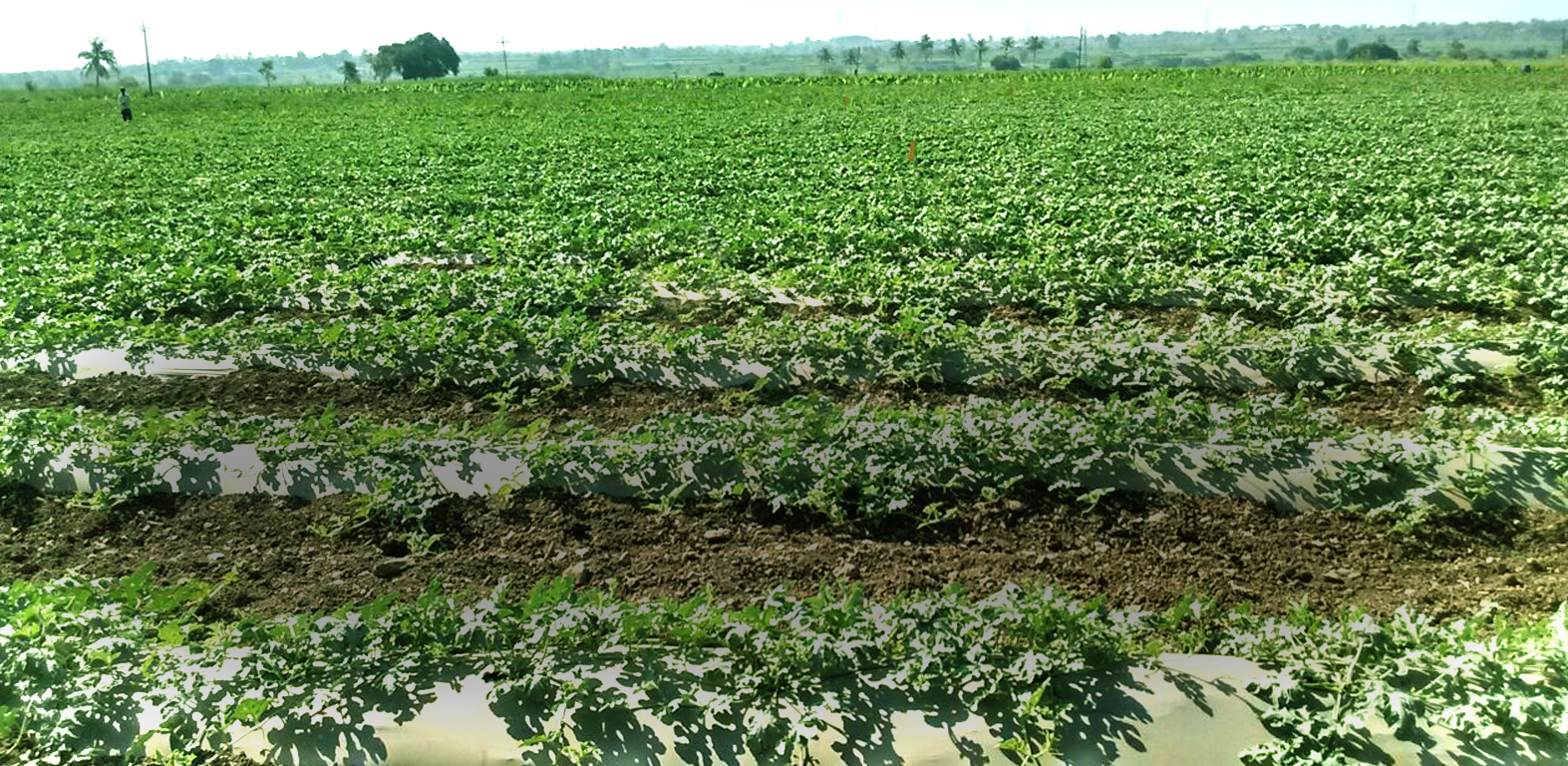Welcome to Jain Irrigation Systems Ltd.

Blog at Jains - HOW MUCH WATER DOES MY CROP NEED? Part 10. Watermelon
Watermelon is one of most popular fruit in the country. Watermelons are mostly water, about 92%, but this refreshing fruit is soaked with nutrients. Each bite has significant levels of vitamins A, B6 and C, lots of lycopene, antioxidants and amino acids. There's even a modest amount of potassium. Plus, this quintessential summer snack is fat-free, very low in sodium and has only 40 calories per cup. Watermelon's high lycopene levels — about 15 to 20 milligrams per 2-cup serving, is noted by scientists and dieticians.
Water melon is Citrulus lanatus, belonging to Cucurbitaceous family. It has a short growing season and it prefers cool climate and in warmer climates with long growing seasons. In the tropics, the dry season is the best season for watermelon growing. Watermelons do not cope well with extreme heat or with the humid, soggy conditions of our wet season /summer. Warmer soil helps germination. Fungal diseases and insects will wipe them out in wet and humid conditions.
Watermelons do best in loamy, sandy, well-drained soil and pH of 6-7 (slightly acidic). Growing the vines on raised ridges ensures good drainage and will hold the sun’s heat longer. Plan to space the plants about 60 cm apart on a 1.5 m wide bed with 30 cm path (furrow). It can be also grown in ridges kept 1.8 m apart. If direct seeding outdoors, sow 4 to 6 seeds per hill, eventually thinning to 2 to 3 seedlings. Watermelon can also be raised by transplanting seedlings raised in a nursery.
In India, this crop is grown either as an intercrop or sole crop. Watermelon can be cultivated in any season in the southern peninsular India; but very hot summer and frost in the winter restricts the growing period in the north. As a sole crop watermelon is generally grown as a short crop between the two major crop seasons, Kharif and Rabi. However, it is generally planted as a summer crop in most states. As such some 30000 ha is planted with watermelon producing 350,000 ton of the fruit.
Water for Watermelon
Estimate of water use by the crop is becoming a necessity as the water availability is shrinking and it is known that water melons do not like excess soil moisture at any time of their growth. Growers are also looking for opportunities to improve water productivity, by conserving water or reducing its consumption. At this point one start asking "How much water does my crop need?
Moisture stress affects the growth and development of the plant especially during the fruit growth stage. Drip irrigation is proved to be ideal for Watermelon and the water requirement is precisely estimated for each location.
Where does all the water go after one irrigates a crop field? Water moves out of the field in 7 different ways after an irrigation that floods the field: 1.Direct evaporation from the water surface, 2. Drift of water away from the field due to wind, 3. Transpiration through the body of the crop plant (Mainly thru leaves), 4. Evaporation from the wet ground exposed to the atmosphere, 5. Run off of water from the field, 6. Infiltration to lower soil strata and 7. Deep percolation to far deep soil profile.
Among these, the essential components of crop water use are only two: transpiration and soil surface evaporation. Hence water use by crop is referred to as ETP, Evapotranspiration. As the crop grows the surface evaporation gets reduced and when the soil surface is fully covered by the canopy (leaf and leaf bearing branches of the crop) there is only one dominant component of crop water use: Transpiration.
In precision irrigation, the water given should only be equivalent to ETP. The goal of perfect irrigation is to reduce the second component of water loss, surface evaporation. In conventional irrigation major part of water loss are in fact the rest of the 7 listed above.
When a farmer asks the question, HOW MUCH WATER DOES MY CROP NEED? The answer is the ETP (evaporation plus transpiration). Accordingly, I have estimated the water required for a good high productive Watermelon crop. The difference among the regions is due to difference in evaporation rate during the growing season of the crop.
How Much water I need for Watermelon crop?
Table CROP WATER REQUIREMENT OF WATERMELON CROP IN DIFFERENT LOCATIONS IN INDIA.
| Regions of Production | WR mm |
WR m3/ha |
| Southern Peninsular India - Kanchipuram, Tamilnad | 456 | 4560.2 |
| Southern Peninsular India -Nalgonda, Telengana | 373 | 3730.6 |
| Southern Peninsular India- West Godavari, AP | 377.5 | 3774.6 |
| Central India - Indore, MP | 364 | 3640 |
| Central India- Raipur, Chhattisgarh | 415.7 | 4156.8 |
| North India- Karnal, Haryana | 339.7 | 3396.7 |
Precision Irrigation and fertigation for Watermelon is maintained by drip method of irrigation.
Drip irrigation for Watermelon
Inline drip line with 4 lph emitters spaced at 40 or 60 cm is found suitable for the crop. The lateral spacing of 1.8 m as row to row distance of the crop is 1.8m.
In the field, for a growth period of 75-80 days, watermelon needs 3400-4600m3 water per hectare and produce an yield up to 50 t/ha of fruits under drip - fertigation assisted precision farming.
Applying water as per the estimates above is possible only through drip method of irrigaton. In conventional irrigation system the whole season consumes more than 8000 m3 on an average, considering the way farmers apply irrigation water and the productivity is 24 t/ha.


